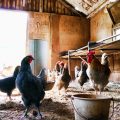Native chicken plays an important contribution to the economic wellbeing of rural farming communities in the country. In spite of being inferior in terms of productivity compared with commercial chicken breeds, majority of smallhold farmers opt to raise native chicken as a source of food and additional income as it does not require special care and management. It can thrive on locally-available feedstock, resist major pests and diseases, adapt to new surroundings, and withstand climatic changes.

The demand for native chicken in the market has also steadily increased because of its unique taste and suitability to many local dishes. Local restaurants and catering services are looking for regular and stable supply of native chicken meat in the market.
However, low productivity remains a problem for the backyard raisers due to the relatively small body size and low egg production performance of native chicken. Thus, Dr. Francisco B. Geromo of Zamboanga Peninsula Integrated Agricultural Research Center (ZAMPIARC) of the Department of Agriculture-Regional Field Office 9 (DA-RFO 9) led the conduct of a project titled, “Community-based Native Chicken Project.” Funded by the Bureau of Agricultural Research (BAR), the project aimed to help in packaging and commercializing the technologies related to community-based native chicken production in Zamboanga Peninsula.
Through the project, the following interrelated studies were conducted: 1) profiling of native chicken; 2) growing and selection of upgraded breeder stocks; 3) crossbreeding of native chicken with four upgraded roosters; 4) growth performance of upgraded chicken; 5) egg production and hatchability performance of upgraded chicken; 6) profitability assessment; 7) sensory evaluation and acceptability testing of four upgraded chickens; and 8) mass production of upgraded chickens for dispersal in the community.
Results of the project
The study elicited significant findings regarding crossbreeding of the native chicken with four upgraded roosters. It was found that the offspring (F1) of the four upgraded roosters namely Kabir, Sasso, Jolojano, and Plymouthrock crossed to native chicken has no significant difference in terms of weight. However, the Jolojano breed crossed with native chicken was found more resistant to pests and diseases with good mothering ability. All the crosses reached maturity in 4-5 months. Likewise, when the four upgraded roosters (F1) were crossed again with native chicken in the farmers’ field, egg production and weight of eggs were not affected by any of the four upgraded breeds of chicken.
In terms of hatchability performance, it was observed that natural incubation gave higher percentage of hatchability as compared with those subjected in artificial incubation for four upgraded breeds crossed with native chicken, with hatchability performance ranging from 81-83 percent and 61-63 percent, respectively.
The upgraded Kabir crossed with native chicken has significantly higher weight of about 1.81 kg as compared with other upgraded chickens. The offspring of native chickens showed the lowest gain in weight of about 1.48 kg. Likewise, offspring of upgraded Kabir and native chicken was more efficient among other upgraded chickens, which required only 8.36 kg of feed in producing a kilo of meat. An on-farm study revealed that Kabir crossed with native chicken got the highest Return on Investment (ROI) of about 17 percent and net return of Php 882.84 compared with rest of upgraded chickens and the native. Native chicken crossed with native chicken got the lowest ROI of about 0.38 percent and net return of Php 19.47. Thus, it is recommended to go for upgraded Kabir as it was found superior in terms of weight and efficiency in feed conversion.
For egg and chick production, it was observed that the average egg production and mean weight of eggs were significantly higher in four upgraded chickens crossed with native as compared with native crossed with native. The four upgraded chickens produced on a average 12-14 pieces of eggs at 45-47 grams, in which the upgraded Jolojano has the highest egg production at 14 pieces, while the native crossed with native has an average egg production of 11 pieces and mean weight of eggs of about 45 grams.
Evaluation was also conducted during the production of upgraded native chickens (F2) for massive distribution in support to DA dispersal program. During the test done on farmer-cooperator’s farm, it was revealed that the number of egg produced by upgraded Jolojano crossed with native was noted significantly higher of about 14 percent comparable with upgraded Plymouthrock crossed native of about 13 percent. Likewise, the same trend was noted in the mean percentage hatchability which was about 94 percent. However, weight of eggs and percent mortality were not influenced by four upgraded chickens. ROI and net return were noted highest in upgraded Jolojano crossed native of about 91 percent and Php 56,480.00 respectively.
In terms of marketing, whether it is live chicken, dressed, or cooked, both the raisers and traders preferred to sell the chicken as live. Then, the most preferred recipes for the chicken by two eatery owners surveyed in the study were the grilled and chicken stew “tinibuok”.
The odor, color, taste and over all acceptability of the quality of raw meat were not influenced by the four upgraded chickens crossed with native during the sensory evaluation. Likewise, when the upgraded chickens were subjected to different menus such as oven-roasted and grilled, the consumers’ preference was not also affected. ###






